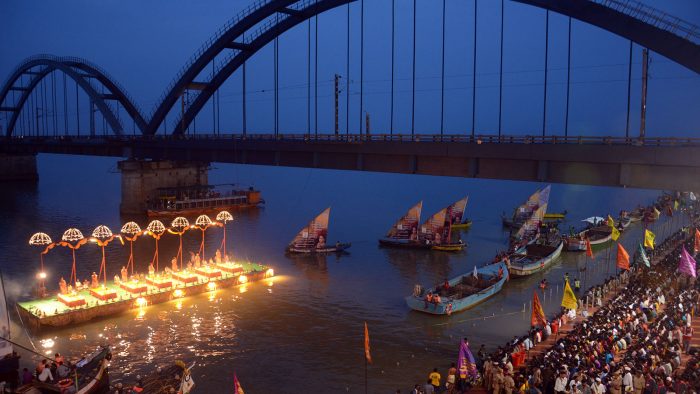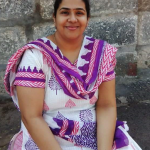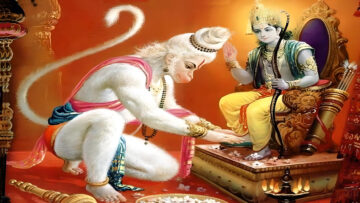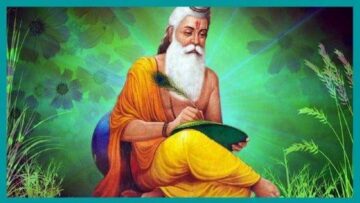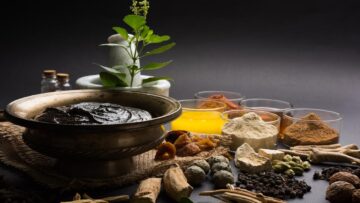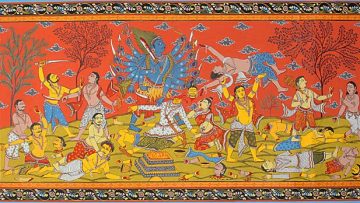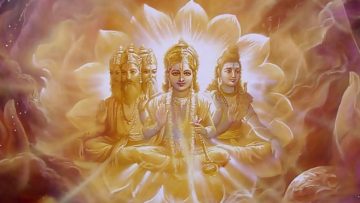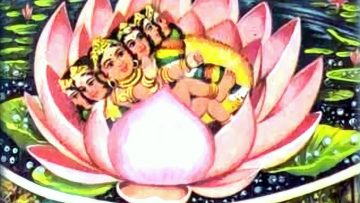Rivers, an integral part of Mother Nature are the lifeline of civilization. Most
ancient societies have evolved around major rivers. Especially in an agrarian
economy like that of India, they have always been the foundation of personal,
social, and commercial lives. India has an intricate and widespread network of
rivers and their tributaries. They are responsible for providing food, water,
irrigation for crops, means of navigation, and more.
Apart from these secular connotations, in India, they are considered to be
feminine divinities, with life-giving and life-taking abilities. They are associated
with positive attributes like prosperity, longevity, fertility, abundance, bounty,
and good health; as well as negative concepts such as death, illness, and
destruction.
This is further accentuated by the ritual attribute of water to cleanse
a believer of his/her sins, which s/he may have committed in the current or past
lives, so also the polluting features associated with death. With all these features,
they are deified as Mother Goddesses. The River Godāvarī is one amongst such
sacred rivers.
The second longest river in India after River Gaṅgā, the eastward flowing Godāvarī
originates in the Western Ghats in Trimbakeshwar in Nashik district of Maharashtra;
and merges into the Bay of Bengal, near Rajamahendravaram in West Godāvarī
district of Andhra Pradesh. Covering almost 1500 KMs through the states of
Maharashtra, Andhra Pradesh, Telangana, and Union Territory of Puducherry,
she crosses almost the entire breadth of South India.
She forms one of the largest river basins in India with her massive network of tributaries like Pravarā, Pūrṇā, Prāṇahitā, Śabarī, Mañjirā, Indrāvati, and many others.
Besides this practical significance, Godāvarī is also a mythological and religious
entity, like all other major Indian rivers. She has an overwhelming number of
tīrthakṣetras along her either banks, as well as at the confluences with her
tributaries.
Stories are woven around these sacred sites, as the intrinsic sacredness
of the river is amplified by the stupefying experiences in her periphery that are
recorded in these myths. The actual identification with geography seems to
elevate the sacred stories to an even higher plane; while they add a touch of sacred
authenticity to the simple towns and sites, thereby giving them a special sacred
status. Therefore, these stories in a way associate the Natural with the
Supernatural, the Sacred with the Profane.
In the development of Hindu traditions, the stories often are interwoven in the
the collective consciousness of the people; culminating into a series of mythical
sacred tales highlighting the greatness of a given site, river, mountain, or even a
specific deity. They are Sanskrit verse style religious texts, usually affiliated with
a purāṇa, and are celebrated as māhātmya [1].
Rivers connect together the various sites that they flow through; by the course of their movement. They allow an actual physical link between otherwise unrelated places. Therefore, māhātmyas associated with rivers are always linked through a common thread. Godāvarī also has her own māhātmya texts.
The paper is divided into three parts:
- Introduction of the Gautamī-Māhātmya as well as the Śrī Godā-Māhātmya
as the texts are not much popular for the audience. - Sacred stories and their contemporary identifications
- Probability of developing spiritual tourism in this region: Newer vistas of
tourism.
Part I:
The Gautamī-Māhātmya, an appendix to the Brahmapurāṇa discusses the
evolution of the sacred geography of Godāvarī. The tentative date of
the composition of this text is between the 7th and 13th centuries CE [2].
The hold of this narrative is certainly strong on the folk mind, evident through the localized Marāṭhī rendering of the section called Śrī Godā-Māhātmya. Śrī Godā-Māhātmya is a poetic composition of thirty-one chapters/ adhyāyas, composed by Dāsagaṇū Mahārāja (Ganesh Dattatreya Sahasrabuddhe- 1868-1962 CE).
Though the text is based on the Gautamī-Māhātmya, it is not a mere
translation. He has given his own inputs based on the sociological, historical,
political, and cultural changes in Maharashtra. He has localized and updated
the text as per the changing times.
Part II:
Both these texts include a variety of stories associated with Godāvarī and sites on
her banks. But, the present paper focuses on the idea of replication of Bhāgīrathī,
the Northern Gaṅgā in case of Godāvarī, the Southern Gaṅgā, replete with her
entire sacred geography.
Replication of sacred geography is fairly common in puranic traditions. Often,
deities are said to be replicas of one another, or visiting each other, or even at times migrating from their original place to another. An interesting case that can be elaborated to illustrate this point is that of Kālabhairava of Shrivardhan in Coastal Maharashtra.
Kālabhairava at Harihareshvar, another sacred site further south on the same
coast, is said to have been born from the fire that erupted from the mouth of Śiva
when he ventured to kill a demon called Śatāghna [3].
After Kālabhairava of Harihareshvar became famous as a potent center for warding off possessions, the Kālabhairava of Kashi decided to pay him a visit. So the Kālabhairava from Harihareshvar stood waiting for him, facing east.
Kālabhairava of Kashi was supposed to reach Harihareshvar before the break of dawn. However, the dawn broke before he reached the destination. The Kālabhairava from Kashi could not reach Harihareshvar and settled in Shrivardhan instead.
Therefore the Kālabhairava at Shrivardhan is considered to be the same as the
one from Kashi. Hence it is believed that one can offer their worship or votive
gifts here, instead of traveling all the way to Kashi. The sacred mythology and
geography associated with Godāvarī in both her māhātmyas can be compared
with the sacred stories and geography of Gaṅgā.
As deliberated upon by Anne Feldhaus (Feldhaus: 2003, pp.158-169), the
comparison between the two Gaṅgās is at times of nature
X= Southern Y
(Godāvarī is called Dakṣiṇa Gaṅgā.)
Or at times,
X is older than Y.
(Godāvarī is called Vṛddha Gaṅgā as she is older than Bhāgīrathī or the Northern
Gaṅgā.)
And subsequently,
X > Y
(Gautamī Gaṅgā or Godāvarī is superior to Bhāgīrathī Gaṅgā, as the later was
summoned by a Kṣatriya, King Bhagīratha, while the former descended at the
requests of a Brāhmaṇa, Sage Gautama.)
She opines that this interrelationship underlines the distance between and the
inferiority felt by the Southerners with reference to the North. This we do not
agree.
Let us evaluate some examples from both Gautamī-Māhātmya and Godā-
Māhātmya to understand this relationship better.
In the first chapter of Śrī Godāmāhātmya, Dāsagaṇū Mahārāja clearly states that
his work is based on the sanctity and greatness of river Godāvarī as described in
the Brahmapurāṇa, which has been composed by Sri Vyāsa. Interestingly, the
first adhyaya of GM begins with a slight deviation.
It says that Śaunaka and other sages asked Sūta about the greatness of Godāvarī. Sūta narrated the dialogue between Brahma and other sages lead by Nārada. It becomes a third-person narrative. However, the BPGM begins with the first person narrative dialogue between Brahma and Nārada along with other sages.
In both, the texts Nārada initiates the discussion. We feel that this is symbolic of the nature of the narrative of Dāsagaṇū Mahārāja. Brahma Purana is directly narrated by Brahma to Nārada etc. Here Dāsagaṇū Mahārāja plays the role of a middleman.
Similarly, the Sūta is in the role of a middleman telling the hearsay story of the prominence and eminence of Godāvarī. Much akin to the text, he discusses the stratification of Tīrthas as Deva, Ṛṣi, Mānuṣa, and Rākṣasa(GM 1. 34-36) and (BPGM I. 5-7).
In depicting the greatness of the river Godāvarī, his poetic fancy tempts him to
employ a simile: ‘Amongst all the rivers, Godāvarī is superior, like parijāta
amongst fragrance and Kohinoor amongst diamonds (GM.1. 34.)’. The simile of
Kohinoor is obviously absent in the BPGM, as it is a colonial addition.
Following the lines of BPGM, the GM proceeds in describing the origin of the
river through two stories: Firstly, the story of the origin of Vālakhilyas by
Brahmadeva. In this story, in order to be cleansed from the sin, Siva gives him a
kamaṇḍalu full of waters, which is used by Brahmadeva to worship the feet of
Viṣṇu as Vāmana. Four streams of waters flowed from the feet of Viṣṇu, the
fourth one moving southwards was held by Śiva on his matted locks.
This fuelled jealousy in the heart of Parvatī. Gaṇapati, thought of a plan, according to which Gautama played a significant role in getting this Gaṅgā flow from Trimbakeshwar.
These details, described in seven chapters are summarised in the GM within one chapter only (Ch. 3). Both the Māhātmyas stress about two streams 1) brought by Bhāgīratha and 2) Gautama. But Bhāgīratha brought Gaṅgā later than Gautama.
The narrative says: Later on, another branch of the river was brought down by Bhāgīratha which entered the nether regions to bestow salvation for the great-great-great grand uncles to Bhāgīratha. After the task was fulfilled, Bhāgīratha sent Gaṅgā to The layas, which flows till today, taking into its fold a large area of northern India. The narration of this river highlights the caste hierarchy within it.
Godāvarī is superior to Gaṅgā/ Bhāgīrathī as it was brought down by Gautama, a
Brahmana and the Gaṅgā flowed because of Bhāgīratha, a Ksatriya. Hence
Godāvarī is called Brahmanadī and Gaṅgā Kṣatranadī [4]. Moreover, as her descent for before Gaṅgā, she is regarded as the elder sister of Gaṅgā and named Vṛddha Gaṅgā.
The context of this text is to thrust the superiority of Godāvarī to Gaṅgā,
which is a paradigm of sacredness. She is called the Daksiṇa Gaṅgā. This
Dvairupa Gaṅgā is mentioned by GM too [5].
But, the really interesting portion starts in the GM, wherein Dāsagaṇū Mahārāja
identifies the places dotted on the Godāvarī river tract. He gives additional
information that there is an image of river Godāvarī at the Varāhatīrtha.
The BPGM mentions about Nilaparvata and Nila Gaṅgā (9. 4), which is dropped by
Dāsagaṇū Mahārāja. However, Nilaparvata is very much located in the vicinity
of Trimbakeshwar. Instead, he mentions that this place was a seat of Nātha
tradition, for Gorakhnatha resided in this place and was gifted with the
Sabarividya.
Moreover, the Samadhi of Nivrttinatha of the Varkari tradition is
also located at Trimbakeswar ( GM. 6. 18-22). This is how Dāsagaṇū Mahārāja
has made additions in the text. In this way, the living traditions through regional
literature exist in contemporary times.
The Kapotatīrtha mentions of the divine love between the male and female pigeon
and the Mukti which they attained on sacrificing life for each other. This place
is also associated with deities like Kārtikeya, Agni, Varuṇa, Rāma esp. because
he performed the funeral rites of Daśaratha, Aśvins, Indra, who cleansed of his
sins because of destroying Vṛtra, Kubera, who attained prosperity after having a
dip in the Godāvarī, tc.
The Kuśāvarta is the place sanctified with these occurrences, say both the texts. BPGM mentions that this place is full of Kuśa grass (10. 2-3) and is the place for offering ablutions to the manes. By the time of Dāsagaṇū Mahārāja, the earlier Peshvas had built a beautiful temple at this site.
So, he supplements this myth with the information of the temple at Kuśāvarta. The strife between Garuḍa and Nāgas ended on the banks of this river and the two tributaries namely Kadru and Suparṇā joined the Godāvarī.
This indicates the acceptance of sanctity of the river by different types of living beings right from celestial beings to animals and birds. The story of sage Kaṇva settling down on the banks of the river is an important point, which indicates the settlements of Śuklayajurvedī Kaṇva Brahmanas in this area [6].
The GM does support this reference. In my visit to Trimbakeshwar, I came across Brahmins with the surname Kannava, which is the Prakritisation of the Sanskrit name Kaṇva. The story of Yama giving up his duty of taking away the souls of mortals is mentioned further. This increased the burden of living beings on earth.
The earth requested Indra to look into the matter. Indra arrived on the scene with an army to combat Yama, who was protected by the Cakra of Visnu (BPGM 18. 29- 30). This place is known as Cakratīrtha. Dāsagaṇū Mahārāja identifies this as Cakore, which is near Anjaneri (GM 8. 64).
At present, this place is shown with a landmark of Cakra. It is believed that Cakratīrtha is that place, where the mortal remains of anyone who deceases in Trimbakeshwar are immersed, for from this place, the river started flowing in the southern direction on the plains.
The feud between Nāgas and Garuḍas was resolved at a place named Garuḍeśvara says BPGM (Chapter 20). Dāsagaṇū Mahārāja identifies it at Pimpalgaon. In my visit to the place, it was discovered that the village had already submerged under the Gaṅgāpur dam. Hence, it was relocated near the catchment area.
A new temple of Garuḍeśvara was built. This is a Śiva temple with the name Garuḍeśvara. However, in the periphery of the temple, there were some images of Nāgas. The locals, when asked about the significance of this place, did not know anything.
The next significant story is that of Govardhana. The myth of Govardhana is quite remarkable. Nandin was very annoyed and upset about the way cattle were ill-treated. Therefore, he abducted the entire bovine family, which created a chaotic situation on the earth. Finally, all the farmers approached Nandin, who released the cattle only under the condition of performing Gosava as a means of appeasement.
The place where this incident occurred is Govardhana, near Dachakpachak village. Here, there is a temple of Siva named Govardhaneśvara, and the myth is painted on a blackboard. But there are some additions to it. It appears that earlier there was a Śivaliṅga made up of butter. Once,
Cakradharaswami happened to visit the place. Out of curiosity, he touched the linga with his feet, which then got converted into stone.
Part III:
The Gautamī/Godāvarī Māhātmya appended to the Brahmapurāṇa is regarded as an interpolation by scholars like R. C. Hazra. But, such Māhātmya texts have their own socio-economic significance with the cultural landscape of their own territory. They are a part of the tirtha economy since ancient times. But one needs to evaluate them beyond the socio-economic implication. They have wielded influence over life, psychology, and also the literature of their territory.
The sacred stories contained in them have been continuing for centuries together
and have persuaded poets and writers to translate these Māhātmyas in the local
language for wider outreach. This entire area of Nashik is considered to be the ‘Wine Capital’ of India, as over half of the vineyards and wineries of India are located here.
However, Karnataka and Telangana also have great wineries, like the ones in Nandi Hills near Bengaluru. To borrow the words of a great Marathi writer P. L. Deshpande, this ‘drākṣa saṁskṛti’ is duplicable; however, the ‘rudrākṣa saṁskṛti’ is unique to Nashik and Godāvarī. The spiritual potency is the distinctive feature or the USP of this region.
It would be worthwhile to utilize this USP for the economic and infrastructural growth of the Nashik region. Religious and spiritual tourism is an upcoming and rapidly growing field. Though the Siṁhastha Kumbha at Nashik and Trimbakeshwar fetches attention and pilgrims/ visitors to the area, it is a twelve- yearly occasion.
Regular tourism will elevate the cash-flow into the area, fetch governmental attention to improve the basic permanent infrastructure. An informed Godāparikramā on the lines of Narmadāparikramā can be one of the possible steps in this direction.
The few locations discussed in this paper could be some of the points of this sacred journey. If such an activity is undertaken, with due support and affiliation of the government, not only can the ancient sites be revived, the otherwise unknown areas can be brought on the global platform. This will result in awareness and subsequent popularization of the Hindu faith; as well as better infrastructure, employment, and foreign reserve for the country. Similar exercises can be undertaken for other rivers and their sacred geographies.
Bibliography:
Primary sources
- The Brahmapurāṇa. 1985. Nag Publishers: Delhi
- Dāsagaṇū Mahāraja. Śake 1919. Śrīgodāmāhātmya. Śrīdāsagaṇūmahārāja
Pratiṣṭhāna: Gorate - The Brahma Purāṇa. 2004 (1986). Tr. Board of Scholars. Ed. G. P. Bhatt.
Motilal Banarasidass: Delhi.
Secondary sources:
- Eck, D. L. 2012. India: A Sacred Geography. Three Rivers Press: USA
- Feldhaus, A. 1995. Water & Womanhood. Oxford University Press:
Oxford & New York - Feldhaus, A. 2003. Connected Places: Religion, Pilgrimage, and
Geographical Imagination in India. Palgrave Macmillan: New York - Mishra, S. & Ray, H. 2017. The Archeology of Sacred Spaces. Routledge:
London& New York
(This paper was presented by Dr. Madhavi Narsalay and Dr. Mrunalini Newalkar at Indic Yatra conference)
Disclaimer: The opinions expressed in this article belong to the author. Indic Today is neither responsible nor liable for the accuracy, completeness, suitability, or validity of any information in the article.

